 |
Pictures | Patents and Trademarks
Patents & Trademarks
William Fuld | Annie Fuld | Carrie Fuld | William A Fuld | Katherine Fuld | Paul Fuld | Isaac Fuld
William Andrew Fuld
October 1st 1893 - November 19th 1976
Click any picture below to enlarge it and begin a photo gallery
*Your browser must allow popups to view the photo galleries
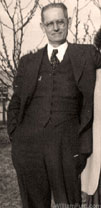 |
| William Andrew Fuld |
William Andrew not only carried on his father's Ouija board business, he also expanded his line of wheeled toys, added a tricycle, made some improvements to a tire tool, and invented an electric pinball machine. Not too shabby eh? In total, he had seven U.S. non-Ouija patents. The first two of these patents (No. 1,373,631 and No. d58,041) were actually assignments from Harry G. Norwood. Harry also assigned three other patents to his father William Fuld. William Andrew's last non-Ouija patent (No. 1,951,973) was on his electric pinball machine, one of only two electric inventions under his belt. Only one patent in this mix lists two Fulds as inventors. William Andrew and his brother Paul Ambrose must have suffered a flat tire which perhaps inspired their new tire tool. Who said everything was about toys? No one's laughing when you blow a tire late at night on a dark road. With the Fuld handy tire tool you'll be on your way in no time!
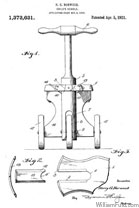 |
Harry G. Norwood
Patent No. 1,373,631 |
U.S. Patents
Patent No. 1,373,631
April 5th 1921
Like his father, William Andrew had a few patents assigned to him by Harry G. Norwood. Both patents had to do with a children's vehicle very similar to today's tricycle. This registrations reads “Be it known that I, Harry G. Norwood, a citizen of the United States, residing at Baltimore in the State of Maryland, have invented new and useful Improvements in Children's Vehicles, of which the following is a specification. This invention relates to vehicles, and more particularly to children's vehicles adapted to be propelled by the occupant. The object of the invention is to provide a child's vehicle that will be easy to knock down or set up, thus facilitating shipment and one which will be inexpensive to manufacture. Another object is to provide a vehicle for children, that will be of knockdown construction, and will be provided with an integral steering head or column, thereby providing a much stronger toy.”
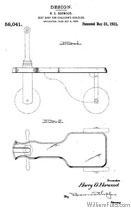 |
Harry G. Norwood
Design Patent No D58,041 |
Design Patent No. D58,041
May 31st 1921
William Andrew's second and final patent assigned to him by Harry G. Norwood is for design of the seat for a child's vehicle. A vehicle doesn't do anyone much good without a seat! It reads “Be it known that I, Harry G. Norwood, a citizen of the United States, residing at Baltimore, State of Maryland, have invented new, original and Ornamental Design for a Seat-Body for Children's' Vehicles, of which the following is a specification, reference being had to the accompanying drawing, forming part thereof. Figure 1 is a side elevation of a seat body for children's vehicle showing the seat body in full lines and Figure 2 is a top plan view thereof. I claim: The ornamental design for a seat body for children's vehicles are shown.”
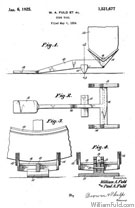 |
William A. Fuld
Paul A. Fuld
Patent No. 1,521,677 |
Patent No. 1,521,677
January 6th 1925
Not many people can claim patent or trademark registrations as their own, and even fewer have the opportunity to register a patent with his brother. This patent on a tire tool was registered by William Andrew and Paul Ambrose Fuld. It reads “Be it known that we, William A. Fuld and Paul A. Fuld, citizens of the United States, residing in the city of Baltimore and State of Maryland, have invented certain new and useful Improvements in Tire Tools, of which the following is a specification. The invention relates to devices for preventing the revolution of a jacked up wheel while the fastenings for a demountable rim are being manipulated, and has as an object the provision of a device which may be placed upon the tire when the wheel is jacked up to prevent awkward movements of the wheel while the fastenings for the demountable rim are being removed or replaced. A further object of the invention is the provision of a device of the class referred to which has a minimum of parts, and therefore is incapable of getting out of order.”
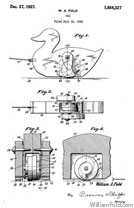 |
William Andrew Fuld
Patent No. 1,654,327 |
Patent No. 1,654,327
December 27th 1927
This patent is William Andrew's first non-Ouija related patent that isn't assigned or shared with anyone. The registration claims that this duck moves in a realistic manner. Can anyone say Aflac? It reads “The invention relates to toys and has an object the provision of a toy animal or bird which when drawn along a supporting surface will have a movement of the limbs and a lifelike motion of the body of the toy. A further object of the invention is the provision of a supporting wheel for such a toy designed to give the lifelike motion referred to. An illustrative embodiment of the invention is shown in the accompanying drawings wherein: Figure 1 is a slide elevation; Figure 2 is a bottom plan view; Figure 3 is a vertical section on line 4-4 of Figure 3. As shown the device has a body 10 which for the purpose of illustration is made in the outline of a duck and a flexible member 11 is shown attached to the body as by means of a staple 12 for traction. To cause a waddle of the body by elevation first one side then the other thereof, there is shown a wheel 13 housed in a recess 14 in the lower side of the body 10 pivoted upon an axis 15.”
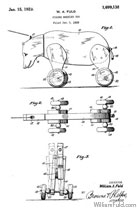 |
William Andrew Fuld
Patent No. 1,699,138 |
Patent No. 1,699,138
January 15th 1929
“Lions and tigers and bears oh my!” Another fine example of the Fuld's wheeled toys, this patent states that though its drawing shows a bear it could be fashioned into any animal. The registration reads “My invention relates to toys and has among its objects the provision of a toy animal or bird when drawn along a suitable support will sway from side to side in simulation of the natural body movement of that animal or bird in walking. Another object of the invention is to so mount the head that it will sway in synchronism with the body. Still another object os to so mount the tail that it will swing in synchronism with the body. One form of structure whereby the foregoing objects are attained is illustrated in the accompanying drawing in which Figure 1 is a side elevation; Figure 2 is a top plan view, and Figure 3 is an end elevation.”
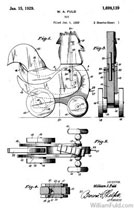 |
William Andrew Fuld
Patent No. 1,699,139 |
Patent No. 1,699,139
January 15th 1929
By now even Colonel Sanders was jealous of William's use of chickens. This is his last patent on wheeled toys and with it he had secured his claim on them. Though the first page of the drawings shows a chicken the second page shows a cat. The registration reads “The invention relates to toys and has among its objects the provision of a toy animal or bird, which, when drawn along a supporting surface will impart a life-like movement to certain of or all the limbs. Another object of the invention is the provision of means whereby a movement from side to side of the head is made synchronous with the motion of the limbs. Another object of the of the invention is the actuation of the head from one of the limbs. Still another object of the invention is the provision of the spacers for certain of the supporting wheels which spacers also serve as the means for actuating the limbs.”
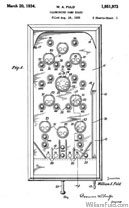 |
William Andrew Fuld
Patent No. 1,951,973 |
Patent No. 1,951,973
March 20th 1934
A complete departure from William's other inventions, this patent was filed along with his unique Electric Mystifying Oracle. William got bit by the electric bug and patented this electric pinball machine. The registration reads “The invention relates to illuminated game boards and has an object a game board equipped for scoring by means of projectiles impelled over the board, the score being indicated by electric lamps associated with each scoring device. It is a further object of the invention to provide a board of this character in which circuit through the scoring lamps is completed by the presence of a ball in position to be played, a circuit closer and a shunt circuit being provided to indicate the final score after the last projectile has been played. It is a further object of the invention to provide a game board having scoring pockets, a plurality of pockets being grouped in a single scoring device. It is a further object of the invention to provide a game board having a signal lamp he circuit through which is closed by the presence of projectiles in position ready to be played. It is a further object of the invention to improve generally upon the structures of game boards of this character.”
|
















